Boeing, Inmarsat and International Launch Services (ILS) enjoy a wealth of successful satellite and launch history among themselves. Inmarsat’s important December launch will mark the milestone of the first of their Global Xpress satellites and subsequent support for secure, government comms. This event is the result of these partnerships. The timeline of this team’s events and technologies are as follow:
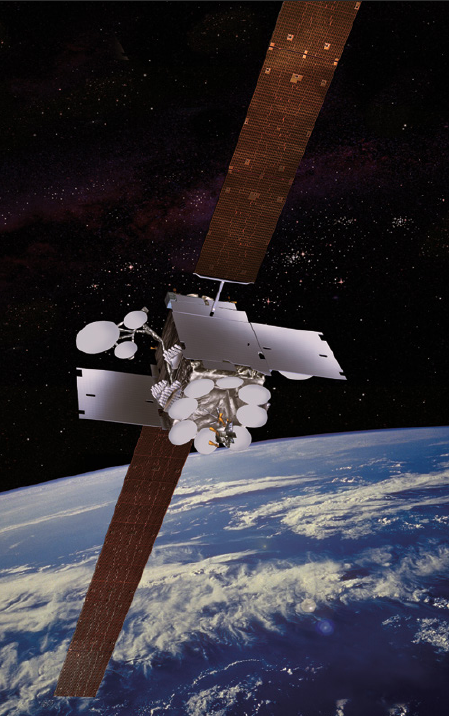
Beginning in 1976, Boeing built three satellites and four payloads for Inmarsat. Marisat 1, 2 and 3 were three L- and C-band communications satellites built for the space segment of the world’s first maritime system.
Of the three Marisat satellites, all exceeded their contractual design life of five years and provided a combined 70 years of service. The HS-356 spacecraft were launched in 1976, one each on February 19 and June 9, and one on October 14.
The satellites were placed in geosynchronous orbit at 15 degrees west longitude, 176.5 degrees east longitude, and 72.5 degrees east longitude, respectively. Boeing also built the L-band payloads that launched on the four Inmarsat-2 satellites during the early 1990s and they continue to operate without a single unit failure to date.
Continuing a relationship spanning three decades, Inmarsat returned to Boeing in August 2010 to order three 702HP spacecraft to provide its new Ka-band global and high-capacity satellite services. In October of 2013, Inmarsat exercised the option to order one more 702HP spacecraft to add to their fleet. Boeing additionally entered into a distribution partnership with Inmarsat to provide L- and Ka-band capacity services to key users within the U.S. government.
Leveraging Boeing’s expertise in government environments and applications, the Inmarsat-5 satellites will provide Inmarsat’s customers with an array of secure voice and high-speed communications applications between land, sea and airservices, and multinational coalitions.
Each Inmarsat 5 satellite will carry 89 Ka band beamsthat will operate in geosynchronous orbit with flexible global coverage. The satellites are designed to generate approximately 15 kilowatts of power at the start of serviceand approximately 13.8 kilowatts at the end of their 15-year design life. To generate such high power, each spacecraft’s two solar wings employ five panels each of ultra triple-junction gallium arsenide solar cells.
The Boeing 702HP carries the xenon ion propulsionsystem (XIPS) for all on-orbit maneuvering.
The Inmarsat-5 F1 Global Xpress satellite is planned for launch on December 8th from the Baikonur Cosmodrome aboard a Proton M launch vehicle supplied by International Launch Services. With a mass of 6,300kg, it will be orbitally slotted in at 64 degrees East.
The ILS Involvement
The Baikonur Cosmodrome where the Inmarsat-5 F1 will be launched via a Proton M launch vehicle is located approximately 2,100 km (1,300 miles) southeast of Moscow.
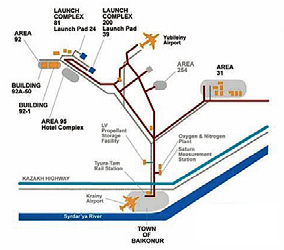
Founded in 1955, the Baikonur Cosmodrome is one of the Russian Federation s two major spacelaunch complexes andhas been the launch site for Soviet, and later Russian, human spaceflight programs, geostationary satellites launches and scientific missions to the Moon and planets.
Baikonur has been the site of some of the earliest achievements in space:
– October 4, 1957: Sputnik,the first man-made satellite to orbit Earth, was launched from Baikonur
– April 12, 1961: Yuri Gagarin lifted off from Baikonur to become the first man in space
– June 16, 1963: Flight of the first woman in space, Valentina Tereshkova
November 20, 1998: Zarya, the first piece of the International SpaceStation (ISS), designedand built by Khrunichevlaunched on Proton
– July 12, 2000: Zvezda,the main componentof the Russian section of the ISS is launched on Proton
The Russian government leases the land upon which the Cosmodrome sits from the Kazakhstan government. The long-term lease is currently set to expire in 2050.
Baikonur is a large Y-shaped complex, shown below, that extends about 160 kilometers (100 miles) east to west and 88 kilometers (55 miles) north to south. The vehicle processing and launch areas are connected to each other and to the city of Baikonur by 470 km (290 mi) of wide-gauge railroad lines. The rail system is the principal mode of transportation. Rockets are carried from their vehicle
assembly buildings to their launch pads horizontally on railcars and erected onto the launch pad.
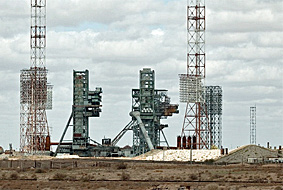
Photo of the Baikonur Cosmodrome’s launch pads.
Two launch pads are available for commercial Proton missions. Launch vehicle and spacecraft time on pad is five days. The spacecraft is transported to the Baikonur Cosmodrome by air and is offloaded at the on-site Yubileiny Airfield. The satellite is then transported to the state-of-the-art processing facility in Area 92 for testing, fueling, mating to the Breeze M Upper Stage, and encapsulation with the payload fairing.
Weather conditions in Baikonur, which is the home of the Proton launch vehicle, have few launch restraints, offering additional schedule assurance for customers.
Khrunichev implemented a Second Spacecraft Processing Facility (SSPF) in Baikonur in 2011 to support ILS Proton missions. The SSPF provides additional manifest flexibility for customers by allowing overlapping launch campaigns, minimizing the required spacing between commercial launches and supporting timely launches on demand.
The Proton launch vehicle is built by Khrunichev State Research and Space Production Center (Khrunichev), Russia’s space manufacturer. International LaunchServices (ILS) has the exclusive rights to market the Proton vehicle commercially under the majority ownership of Khrunichev.
The ILS Proton Breeze M has the lift capability of more than 6 metric tons to geostationary transfer orbit and is compatible with all major spacecraft platforms. With the flexibility for geostationary and super-synchronous transfer, highlyelliptical and direct geostationary insertion mission, the Proton launch systems provides precise delivery to orbit in a robust, flexible, high performing package.
The Phase IV Proton performance increase will be available starting in mid-2014. The mission profile can be optimized to maximize satellite fuel life.
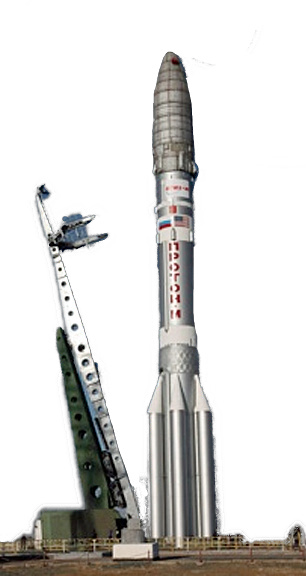
The Proton Breeze M launch vehicle
A previous ILS launch for Inmarsat occurred on August 19, 2008, when theInmarsat 4 F3 satellite was launched by the Proton M / Breeze M rocket, which was ILS’ third launch of that year. The photo below is of that specific launch and is courtesy of ILS.
In Inmarsat’s Interest
The Inmarsat-5 F1 is the first of the company’s Global Xpress satellites. Global Xpress will be the first global Ka-band network and has been built specifically with government customers in mind.
The satellite will deliver secure, end-to-end wideband connectivity for seamless airborne, naval and land operations worldwide—Inmarsat has been serving government customers with mission-critical communications for more than 30 years.
GX offers managed services for flexible connectivity on demand as well as steerable, high-capacity leases. The technology is particularly suited to bandwidth-intensive mobile applications for Airborne Intelligence, Surveillance and Reconnaissance (AISR); special operations and expeditionary forces; live fullmotion video (FMV); intelligence; command and control; and theatre backhaul.
Wherever the next mission arises, GX will offer a network that’s owned and managed solely by Inmarsat. Purposely designed for mobility, GX will provide a continuous, consistent service as traffic is handed seamlessly across each spot beam, and from one satellite to another.
As the network is global, GX will deliver higher performance consistently—with a downlink up to 50Mbps and an uplink up to 5Mbps. When there are surges in demand, additional beams are directed to provide enhanced throughput and greater performance.
GX will be the first global, commercial network that’s interoperable with MILSATCOM Ka-band networks, providing resilient, cost-effective augmentation. Using contiguous commercial spectrum, GX will provide global reach and additional capacity for those with existing Ka band networks, and peer capabilities for those without.
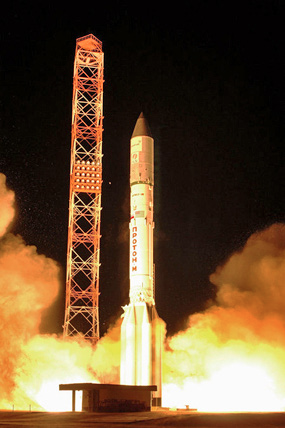
The GX network is base-lined to satisfy U.S. Mission Assurance Category (MAC) level III, with secure gateways and satellite commanding. Secure GX offers enhanced security capable of MAC I/II levels.
GX will deliver higher data rates through more compact and affordable terminals than those in the Ku-band. A broad portfolio of terminals will be availablefor government applications in mobile, portable and fixed formats to suit all environments, from industry-leading manufacturers.
In a climate of continuing budget pressures, GX offers some respite with more affordable services and terminals. Ka-band is more efficient in its use of bandwidth, and, as Inmarsat owns and manages the entire global network, better use of the satellite resources equal significant cost savings for mission requirements.
All three Inmarsat-5 satellites will be launched on Proton vehicles provided by International Launch Services from the Baikonur Cosmodrome in Kazakhstan. Each satellite will be served by two fully-redundant ground stations to ensure the highest levels of network availability.
Inmarsat has also appointed iDirect to develop the ground network and core module technology that will be integrated into satellite terminals.
The full GX constellation is expected to be deployed by 2014, with global coverage
planned for the end of that year.

For more information about Global Xpress, please access the website at: http://igx.com/
Recent, Updated Information Regarding GX
The President of Inmarsat, Miranda Mills, said in October, “The GX Aviation program is firmly on track within our current schedule of being available from early 2015. Under the expert control of the Boeing teams, the satellites are being manufactured and tested to the highest standards. The first launch is on schedule for late this year with full global coverage on course to be achieved by
the end of 2014.
“GX Aviation is changing the face of inflight connectivity. It will be the world’s first global Ka-band network, specifically designed to provide connectivity to aircraft. It will enable a whole range of new services for both passengers and crew.”
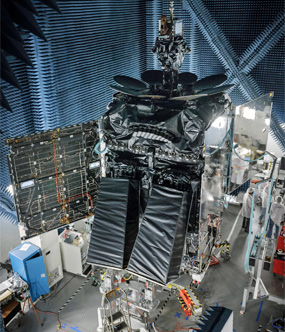
Inmarsat-5 F1 in the A1 chamber at the Boeing Satellite Development Center. Photo courtesy of Boeing.
I-5 F1 Completing Final Tests
The first of the three GX satellites, Inmarsat-5 F1, has undergone the final stages of system level performance testing at the El Segundo, California, facility before it is shipped from Los Angeles International Airport to the Baikonur Cosmodrome launch site in the Republic of Kazakhstan. The satellite is scheduled to fly on an Antonov An-225 heavy transporter in early November, in preparation for a scheduled early December launch.
Launch System
The ILS Proton Breeze M launch vehicle will take the 6,100kg Inmarsat-5 F1 spacecraft to geostationary transfer orbit. From there, the satellite will deploy its solar arrays, with a span similar to that of a Boeing 737. The satellite will then be positioned in geostationary orbit above the Indian Ocean region, around 23,000 miles from Earth.
Inmarsat-5 F2
The second satellite (Inmarsat-5 F2) is in the final stages of its assembly process at the Boeing plant, before it begins a series of tests that simulate the extremes of temperature experienced in space. This will ensure that the heat transfer technology works perfectly. This enables the electronics inside the satellite tooperate at room temperature, despite a difference of around 300°C between the back and front of the satellite.
I-5 F2 will also undergo rigorous simulation testing of the launch conditions, both through vibration and acoustic testing. The acoustic testing uses nitrogen to subject the satellite to up to 152 Overall Sound Pressure Level (OASPL). The satellite’s data transmission and receive capabilities will also be thoroughly tested, including tests over Inmarsat’s Global Xpress ground network.
Fourth GX Satellite Purchased
Inmarsat recently triggered an option to purchase a fourth Inmarsat-5 satellite, under its existing contract with Boeing. The program schedule from Boeing has a satellite delivery date of mid-2016.
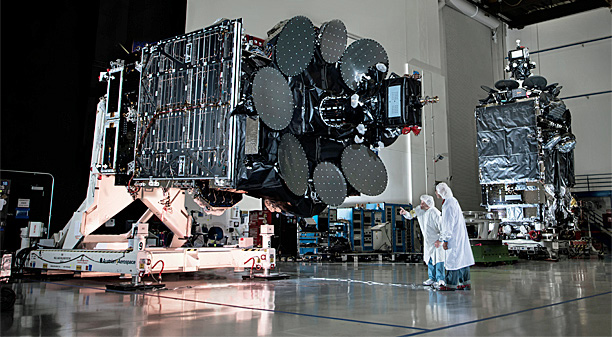
Inmarsat-5 F1 (right) and Inmarsat-5 F2 (left) in Boeing’s El Segundo facility. Photo courtesy of Boeing.

